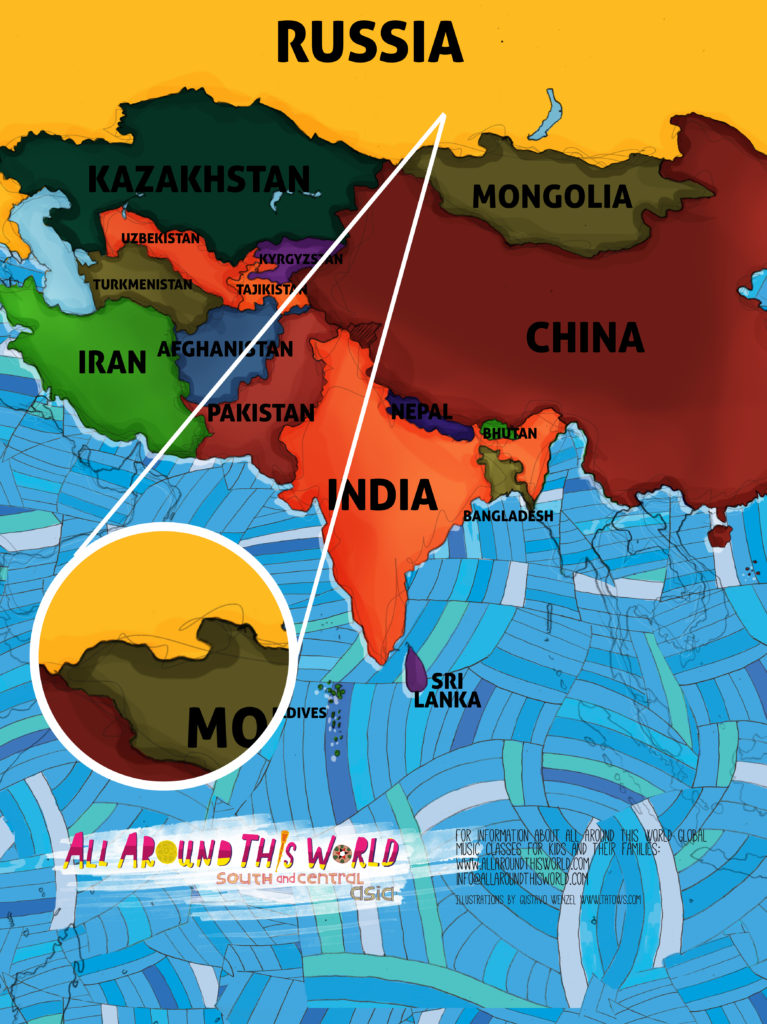Earlier this week we met the Tuvan zither called the chadagan. All Around This World’s song “Chadagan” re-imagines a traditional Tuvan love song we first heard on the Smithsonian Folkways recording, “Musics of the Soviet Union,” listed as “Song from Khomeizhi.” You can sing along with the original version — “Chadaganym Khöömejimni kagbazy Khönü chitpes chadaganym Khölchüng kara urug-bile Khöörezhiir chadaganym . . .” — or start with ours.
Tag Archives | Tuva
The Sweet Sound of the Chadagan
A Tuvan chadagan is a multi-stringed instrument, a bright and luscious “plucked zither.”
Who created the Tuvan chadagan and why? According to this legend, the instrument’s beginning had something to do with an old musician, a hungry baby, and one very generous nine year-old sheep. As we visit Tuva and read the tall tale, listen to Gendos Chamzyryn performing the Tuvan song “Manchurek” on a chadagan.
Say Hello to Huun Huur Tu
Its Huun Huur Tu is a rock band maskerading as a Tuvan throat singng ensemble, or the other way around…?
In traditional Tuvan culture, making music is more than just a frolic; it’s a way to connect with nature. Tuvans simulate the sounds of the wide open plains with throat singing (“overtone singing”), a form of vocalizing in which a singer can make multiple tones at once, high and low. In this video we meet one of our favorite throat singing ensembles from Tuva, Huun Huur Tu.
Tuva is Tremendous

This week in our online class we travel far far FAR away to Tuva. Officially known as the “Tyva Republic,” Tuva s a geographically and, until recently, culturally isolated semi-autonomous part of Russia located in south-central Siberia. The Tuvan people are of Mongol heritage and have traditionally been independent, yurt-dwelling goat, sheep and cow herders (and reindeer!), but since the 19th century when Russians began to settle there, Russian and China fought for control of Tuvan land. When the USSR collapsed in the early ’90s Tuva remained part of Russia, but Tuvans have become much more independent to follow their Buddhist, Tibetan Lamaist and Siberian shamanist religions, pursue the national cultural pasttime — THROAT SINGING! — and make many friends around the world.
Yat Kha takes us to a Tuvan Gadda Da Vida
There is no band better at briging cultral divides than Tuvan punk ensemble, Yat-Kha….
We end our short but very sweet tour of Tuva with one of our favorite things ever. In this video Yat-Kha performs the heck out of the Iron Butterfly song “In a Gadda Da Vida,” throat singing and all. It’s East meets West meets awesome.
See you next week in our online class for a visit to Xinjian.
Once upon a time, at the beginning of the beginning . . .
“Once upon a time, at the beginning of the beginning, behind the past, when the horns of the bull used to break off and fall, that’s the time when it happened, so they say…” So begins the Tuvan epic tale of the camel, as told gloriously by Dabgy Salchak-oolovna Bolat, in Tuva’s Kyzyl-Dag village. Why does a camel go so long without drinking? Why does the deer shed its horns? To find out read the translation in the video’s comment section, courtesy of Enduring Voices an awe-inspiring project to maintain the world’s linguistic heritage.
Late Night Meets Ondar
Tuvan throat singer, Kongar-ol Ondar, is the king of cool….
Tuvan throat singing master Kongar-ool Ondar was one of the throat singers from Tuva who made international waves before his abrupt passing in 2013. Here he is making friends around the world on late night TV.
Alash and Shodekh
All Around This World loves Alash Ensemble, the tremendous Tuvan ensemble with a mission — to take traditional Tuvan throat singing to the international masses!
There are other throat singing juggernauts from Russia’s “Tyva Republic” but Alash Ensemble, as you’ll see in this video, especially endears itself to us because it makes ancient Central Asian traditional singing seem like the sound of the future. We’ll enjoy Alash even more in a few weeks when our class takes us to Tuva.

